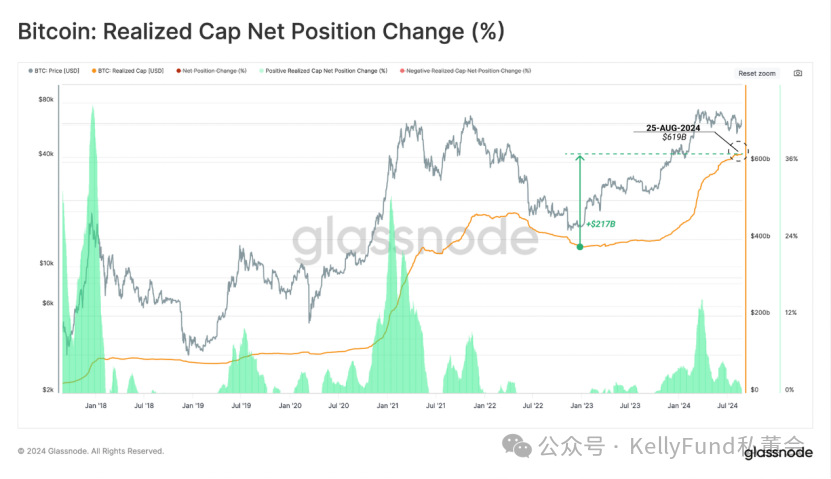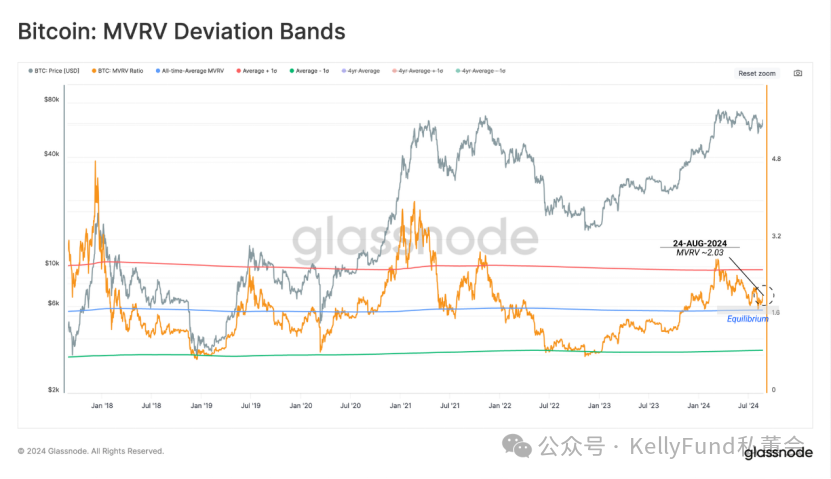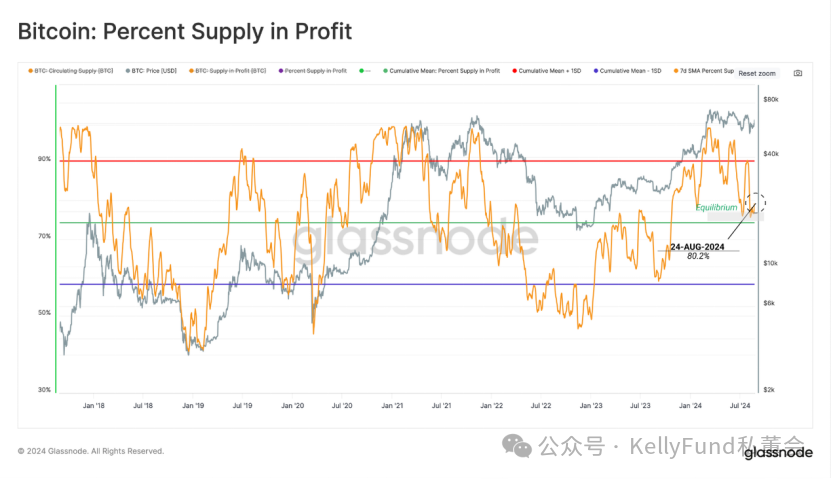On-chain data analysis at the end of August: Is a big fluctuation coming?
Currently, market speculation in Bitcoin is relatively low—not only have investors been able to lock in only slim margins in recent days, but the perpetual swap market has also returned to a state of calm. But historically, such calms are temporary and often portend greater volatility in the future.
summary
● Currently, the net capital inflow into the Bitcoin market has clearly cooled, and investors’ recent gains and losses are very small.
● Almost all losses are borne by the short-term holder group.
● But as a large portion of short-term holders have held their coins for more than 155 days, they have turned into long-term holders.
● Speculative activities in the perpetual swaps market have returned to calm, with both speculative interest and long leverage cooling down.
Market liquidity analysis
Net capital inflows into the Bitcoin market have slowed over the past few months, suggesting that investors are at a break-even point to some extent.
However, capital inflows into the Bitcoin market have rarely been so quiet – on 89% of the days in the past, capital inflows have been greater than in the recent past (except during bear markets). It is also worth noting that similar periods of ennui are often followed by a sharp rise in market volatility.
Despite this, Bitcoin’s total market capitalization remains at an all-time high of $619 billion, while net capital inflows into the market have reached as high as $217 billion since its December 2022 low of $15,000.

The MVRV ratio is an extremely useful tool when we measure the average unrealized profit of investors.
Over the past two weeks, the MVRV ratio has been 1.72, roughly equal to its historical average. This key level often marks a turning point between macro bull and bear trends, and today, the MVRV value is above this average on about 51% of trading days.
This shows that investors' profitability has basically returned to a balanced position, and the market's excitement and enthusiasm have completely cooled down after the launch of the ETF.

Beyond that, the supply percentage tells a similar story across our various profit metrics.
Like the MVRV ratio, this metric has reverted to its long-term average after a series of swings, as was the case in late 2016, throughout the 2019 volatility, and during the mid-2021 sell-off.

The sell-side risk ratio is another useful tool for assessing the breakeven level of a market. We can think of this metric like this:
● A high value means that when investors sell Bitcoin, they either make a huge profit or a huge loss. At this time, the market price fluctuates violently and may need to find a balance again.
● Low values mean that when investors sell coins, they make little or no money. In this case, the "profit and loss potential" within the current price range has been exhausted, which usually means that the market is generally calm.
Currently, the sell-side risk ratio has fallen to a low level, indicating that most Bitcoins are trading close to their original acquisition price. But despite this, big fluctuations in the future may still be looming.

Short-term financial stress analysis
Digging deeper into investors’ P&L, we can see that their net realized profits/losses are declining.
The current net realized profit/loss is $15 million per day, while in March, when the price of the currency hit a peak of $73,000, this indicator was as high as $3.6 billion per day. It is worth noting that when this indicator returns to a neutral level, it often means a turning point in the market, such as a bull market trend falling and resuming, or reversing to a generally bearish trend.

After hitting an all-time high in March, the confidence of new investors was tested during several months of volatile sideways price action, during which a large number of Bitcoins were held in the 3-6 month range.
Historically, the Bitcoins held for 3-6 months were often bought after the price reached its peak, but then they experienced a deep correction. Despite the volatility, some new investors decided to continue holding, and they eventually became long-term holders. Others exited their positions and sold at a loss.
Currently, Bitcoin held for 3-6 months accounts for more than 12.5% of the circulating supply. This market structure is similar to the market sell-off in mid-2021 and the 2018 bear market.

Next, we will further break down this group and analyze how many bitcoins are held for 3-6 months, and how many of them are returned to the market because of holders selling at a loss. We will visually display the total amount of bitcoins held for 3-6 months and see how many of them are sold because of investors selling at a loss.
We can observe that since the beginning of July, the total amount of Bitcoin held by investors has begun to decline as a large number of investors began to lose money. The scale of investors' "surrender" is similar to that of past market turning points.
As time goes by, Bitcoins in this time period begin to approach static, which means that they will be firmly held by investors and wait for better opportunities.

The URPD indicator is another tool to assess how Bitcoin has turned into a static state, which distinguishes between long-term and short-term holders. Here, we can see that although more than 480,000 Bitcoins are still in a loss state, they have turned into a static state because of the determination of the holders.
This also means that these long-term held bitcoins are currently in a state of unrealized losses.

Market volatility analysis
Next, we will analyze the perpetual swap market to interpret market speculation and leverage demand.
In general, compared to the crazy market in March when the price of the currency hit a record high, the recent forced liquidation events have decreased significantly. This shows that speculative demand has declined and that spot trading is the absolute mainstream in the market at present.

If we compare monthly price volatility to net liquidation volume, it is easy to see that the two factors are strongly correlated. This illustrates that market volatility is often exacerbated by the squeeze of leveraged positions, as investors can easily "cross the line" and get liquidated when the market is volatile.

Next, we discuss the ratio between the coin price and the volatility of net liquidation volume to understand investors’ attitude towards leverage.
We found that this indicator has fallen to its lowest level since February 2022. This proves our point that investors are not willing to take high-risk positions at present, which also shows that the speculative impulse has completely cooled down.

The same phenomenon is also seen in the broader digital asset market, with a large number of other digital assets currently seeing their funding rates turn neutral. This suggests that the speculative interest in the entire market has been wiped out, and therefore, the spot market is likely to dominate in the short term.

Summarize
Currently, both in the on-chain field and in the perpetual futures market, the market is tending to be balanced. This is reflected in the fact that the profit and loss of transactions have decreased, and the financing rates of various digital assets have dropped to a very low level. This also shows that the regular trading and speculative activities of market investors have dropped significantly.
Beyond that, the market has been in an orderly downward trend for more than five months as it began to turn to accumulation. However, based on historical experience, this calm is temporary, and the storm of future volatility is brewing.
Historically, this calm in Bitcoin is temporary and often signals greater volatility to come, so now is the perfect time to try it out for free! https://j.moomoo.com/01fbFg
Disclaimer: Community is offered by Moomoo Technologies Inc. and is for educational purposes only.
Read more
Comment
Sign in to post a comment
